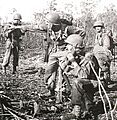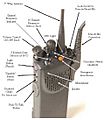Walkie-talkie facts for kids
A walkie-talkie is a special kind of two-way radio. It's small enough to hold in your hand. You can use it to talk to other people who also have a walkie-talkie. It works like a phone but uses radio waves instead of phone lines or cell towers. These devices were first created during World War II.
A smart engineer named Alfred J. Gross worked on the early ideas for walkie-talkies between 1934 and 1941. During the war, other engineers like Donald L. Hings and teams at a company called Motorola, led by Henryk Magnuski, helped make them even better.
Today, most walkie-talkies are about the size of a mobile phone. They have a special button you push to talk. Walkie-talkies are used for many things. Soldiers use them in the military, and people who enjoy amateur radio use them as a hobby. Many people also use them for fun or for work.
Contents
How Walkie-Talkies Were Invented
The very first walkie-talkie was quite big. It was so large that soldiers had to carry it in a backpack. This first model was called the Motorola SCR-300. Motorola made many other walkie-talkies during World War II.
Making Them Better
At first, not many people thought walkie-talkies were a big deal. But when World War II started in 1939, everything changed. The Motorola team worked hard to improve them. Soon, the army could use them to talk to each other on the battlefield. There were even versions made for vehicles and tanks. Countries like Britain, Germany, and the United States all had their own types of these radios.
Motorola also made a smaller radio during World War II called the AM SCR-536. People called this one the "handie-talkie" because you could hold it completely in your hand. Sometimes, people get the terms "walkie-talkie" and "handie-talkie" mixed up today. But originally, the "walkie-talkie" was the big backpack model, and the "handie-talkie" was the smaller, hand-held one. The hand-held versions were easier to carry but usually couldn't send signals as far.
Where Walkie-Talkies Are Used Today
Walkie-talkies are used in many different places. Businesses use them to help staff communicate quickly. Police officers and soldiers use them to stay in touch during important missions. They are also popular for fun activities like hiking, camping, or even just playing with friends.
Images for kids
-
A USDA grain inspector with a walkie-talkie in 1976
See also
 In Spanish: Walkie-talkie para niños
In Spanish: Walkie-talkie para niños











